This speaker came about due to Max in
Sweden asking for a construction from the ScanSpeak
drivers 15W/8530-K00 and D2804/9800 alu dome, similar to
a construction know as the "A4" (front panel =
dimensions of a piece of A4 paper), a Dutch construction
from: http://www.audiocomponents.nl/speakers/scanspeak/reference/scanspeak-reference_eng.htm
Besides, Max showed some very nice drawings of the
cabinet having curved sides and we decided that he should
make the drawings and pictures of the cabinets for this
article and I would make the crossover, the fine-tuning
and "all the usual stuff". So, here we go:
I have tried setting up the Dutch crossover in my
test-cabs and it really didn't work too well. Treble 2-3
dB too high and the phase tracking was bad. Adding 3R3 in
front of the tweeter made a nicer performance but with a
dip around 2 kHz, so with a few modifications it was
possible to render a more balanced presentation with
significantly improve phase performance and improved
level of transparency.
What we have here is a speaker with a sensitivity around
82-83 dB/2.8V - not surprisingly - as the sensitivity of
the 15W is around 85 dB/2.8V.
The
Crossover
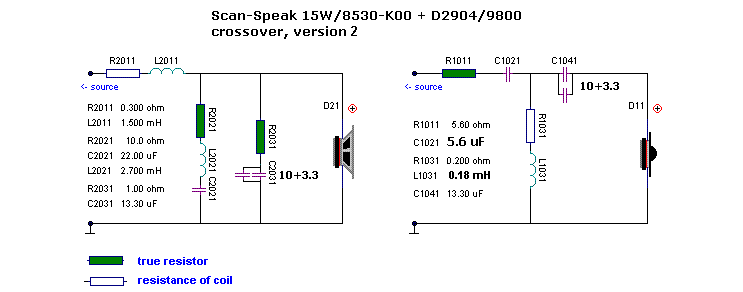
Simplicity
itself: Crossover for 15W/8530-K00 + D2904/9800,
"A4" front panel.
12/18 dB set-up with the usual LCR circuit to get rid of
the (huge) 800 Hz bump.
The Crossover Kit
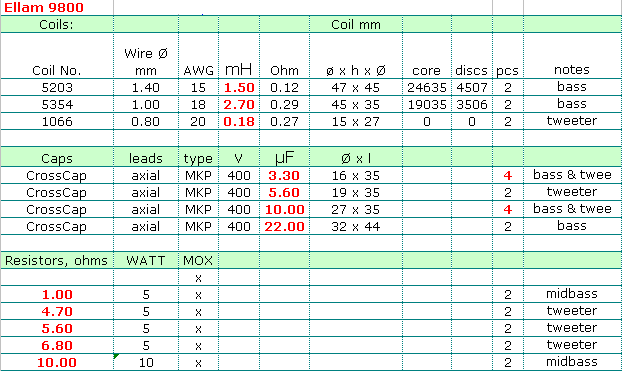
I
have included extra resistors (4R7 and 6R8) to experiment
with tweeter attenuation.
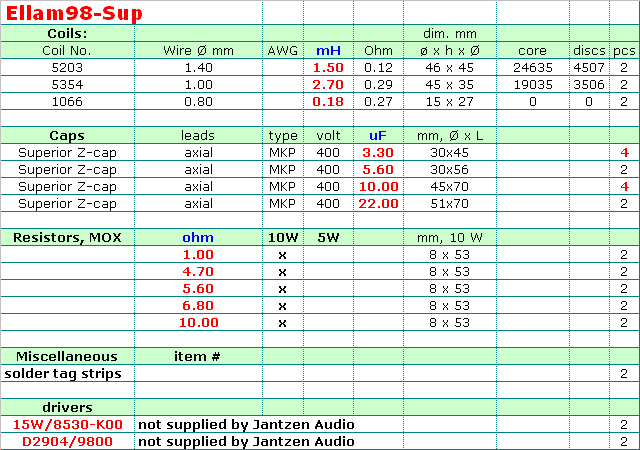
Ellam98 with Superior Z-caps.
Should you decide to try these caps, be prepared to add
additional volume to
accomodate the crossover. These caps are huge!
Complete crossover kits can be bought from
Jantzen Audio: contact@jantzen-audio.com
Cabinet
Plans
- made by Max
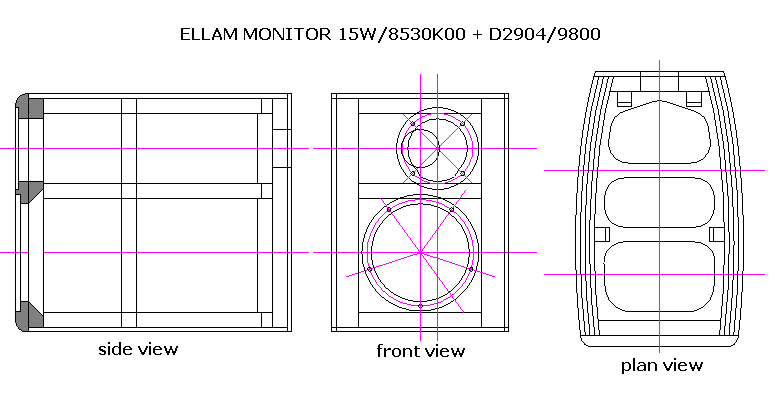
Cabinet
construction, details below:
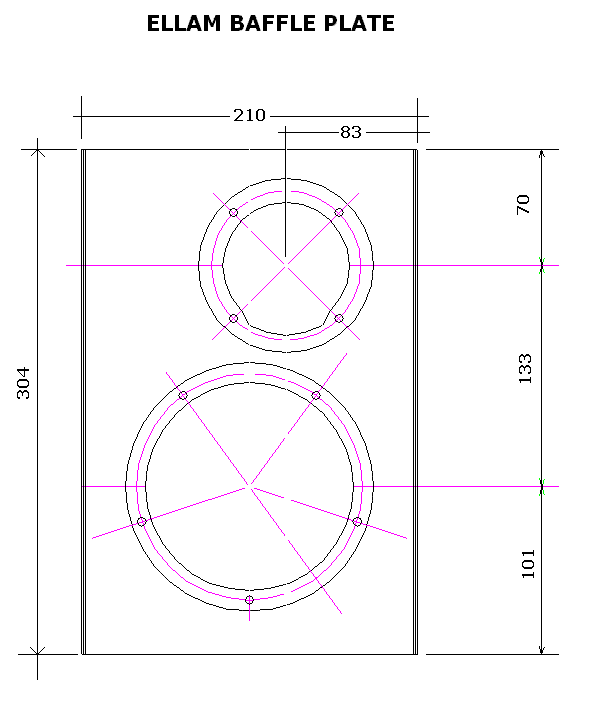
Placement of drivers on
front panel. To get the target SPL, place drivers
as indicated on the drawing here. Cabinet volume
is 10.5 litres and the vent is 46 (ID) x 150 mm,
same as 1500/97
What is important here - as always - are
the dimensions of the front panel and the
placement
of drivers. If you decide to make a cabinet with
curved side panels you will have to figure out
for yourself the depth and curvature of the
cabinet to get a volume of 10.5 litres.
|
Pictures from Max
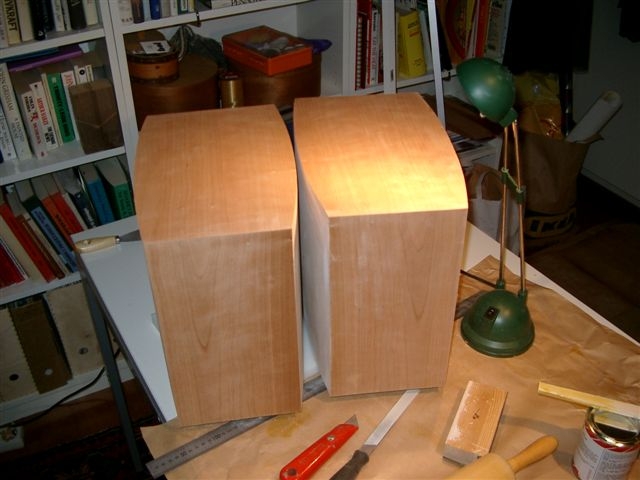
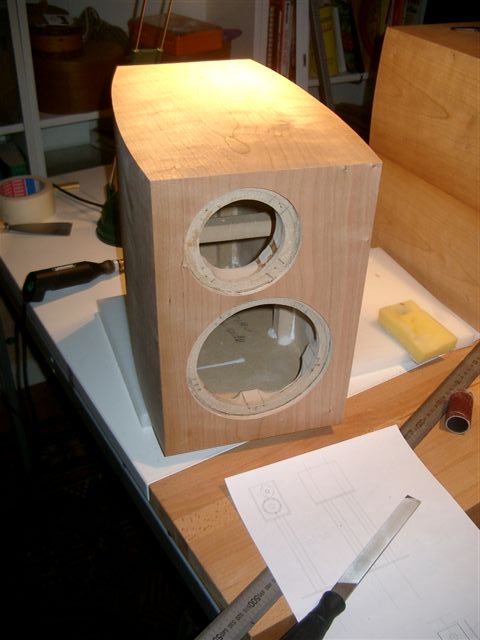
Cabinets
shaping up.
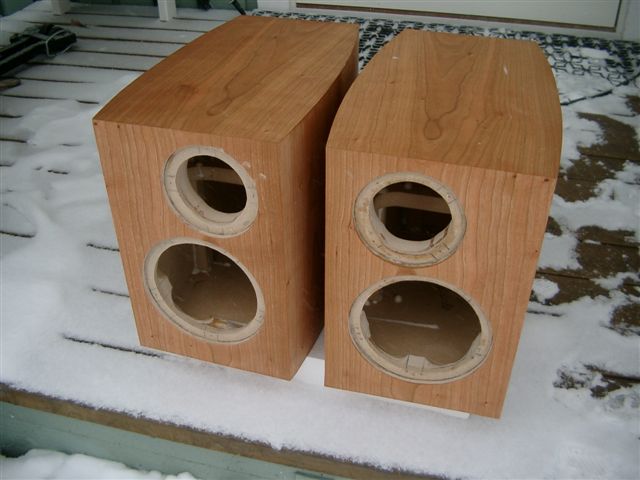
Here
the A4 cabs in the cold Swedish winter!
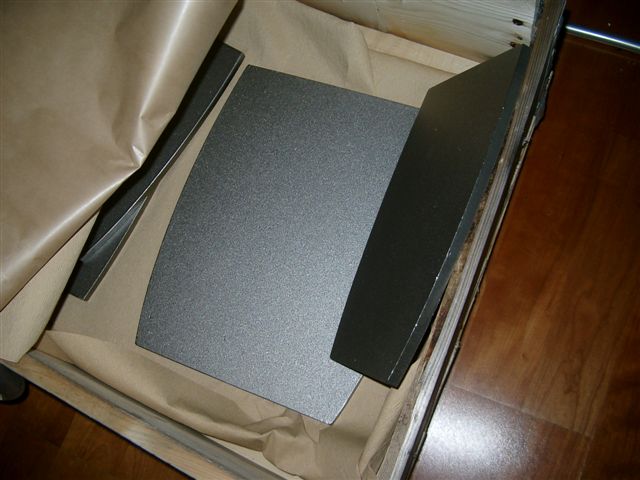
Stands
made from heavy metal sheets.
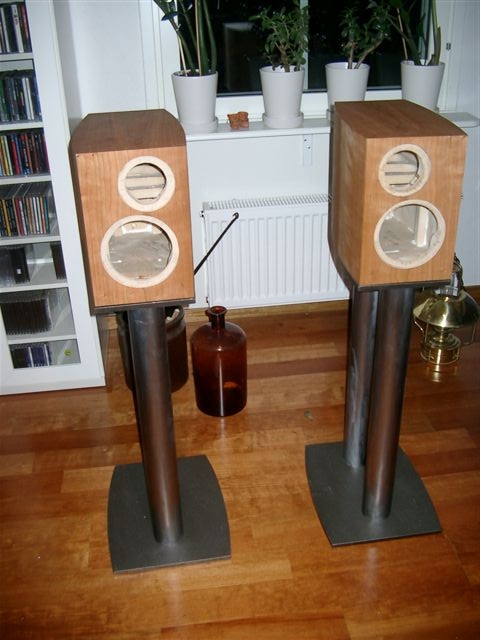
The
finished stands. Solid - and beautiful!
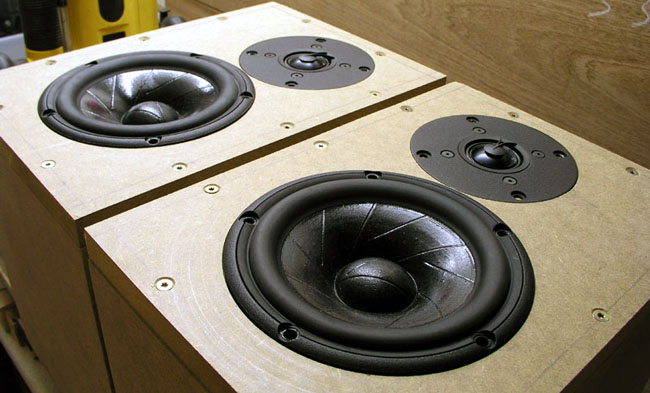
I decided
I needed a new pair of test cabs for this set-up,
thus a 10.5 litres cab was constructed with the
A4 front panel dimensions. The cabinet is 300 x
210 x 280 mm (H x W x D) making a net volume of
10.9 litres. The vent and drivers will reduce
volume slightly. Actually an A4 paper is 297 x
210 mm, but no need to be nitpicking!
|
Measurements
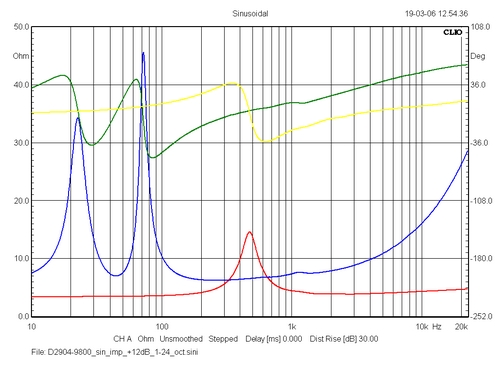
Impedance
and electrical phase of drivers in cabinet.
|
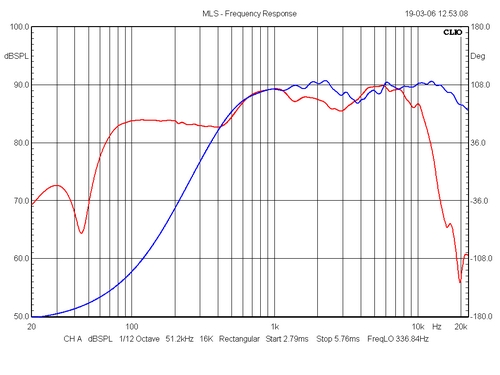
Frequency
response of individual drivers without crossover.
Nearfield response of bass driver merged at 350
Hz with 1 metre distance response. Expected
system sensitivity is around 83-84 dB/2.8 volts.
|
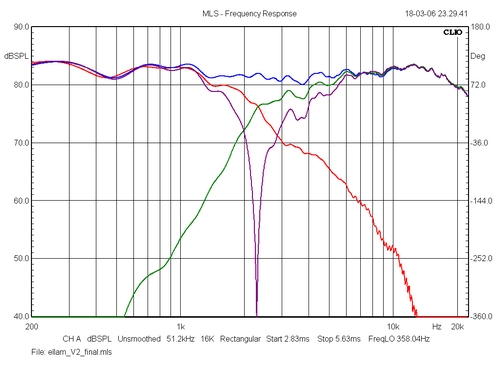
Frequency
response of individual drivers (red and green),
summed response (blue) and response with inverted
polarity (purple). Point of crossover = 2300 Hz.
|
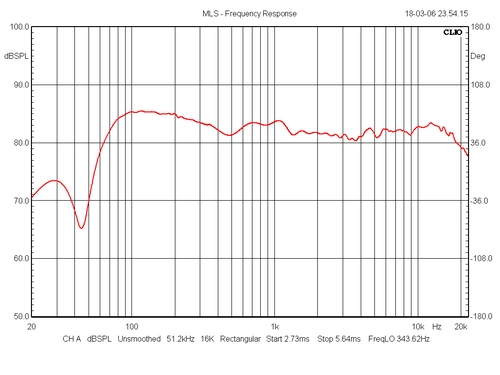
Frequency
response with merged nearfield response at 350 Hz
of bass driver. An overall balanced response with
a more than usual bass extension for a 5"
driver. These sliced paper drivers just are
good at bass.
So how does this response
correspond to LspCAD prediction?
|
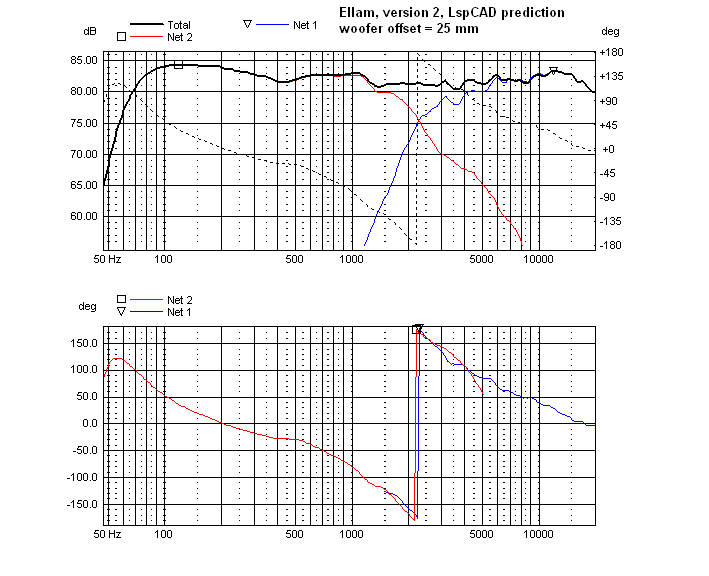
- very good indeed!
The bass driver is here offset by 25 mm producing an
optimum listening position at tweeter height.
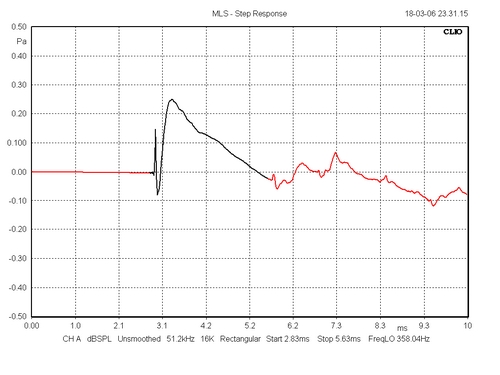
Step
response showing positive polarity of both
drivers. Note smooth decay of bass driver.
|
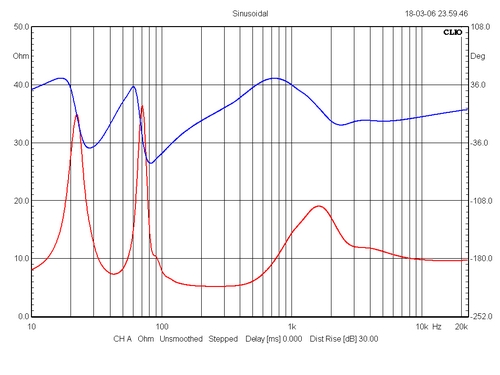
Impedance
plot showing vent tuning of 43 Hz. vent = 35 (ID)
x 100 mm. I suggest using a larger vent diameter,
like 45 x 160 mm.
The combination of a negative 60° phase at 80 Hz
and an 10 ohms impedance may draw some current
from your amplifier, but I haven't noticed any
trouble from my 100 wpc solid state or 50 wpc
valve amp.
|
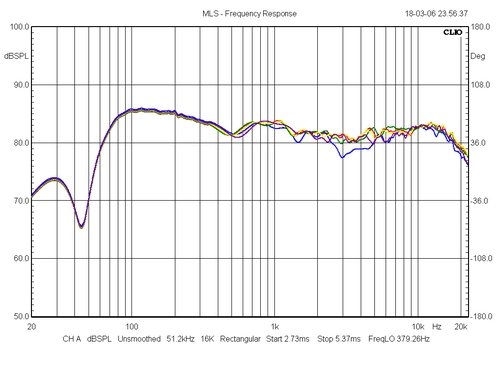
Vertical
dispersion at 1 metre distance. Red = tweeter
height. Blue is 20 cm below. The others: Well,
doesn't matter much.
This speaker has a remarkable good vertical
dispersion and the sound doesn't change much with
listening position.
|
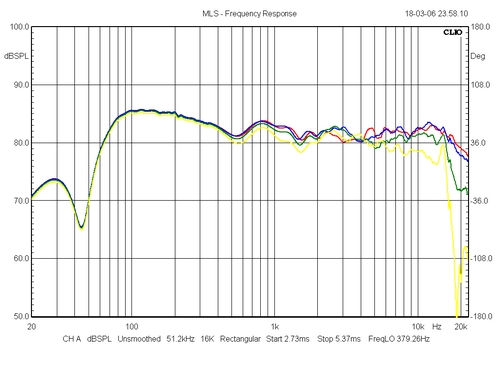
Horizontal
dispertion at 1 metre distance. Yellow = 40 deg.
|
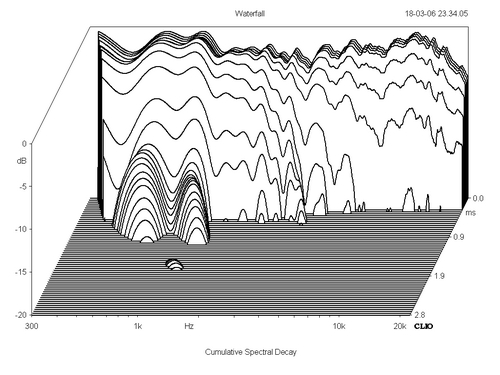
Cumulative
spectral decay. Hmm... Maybe these testcabs could
do with some bracing. Otherwise a good
performance with no severe resonances down to
-20dB above 1 kHz.
|
Final pictures from Max/Sweden
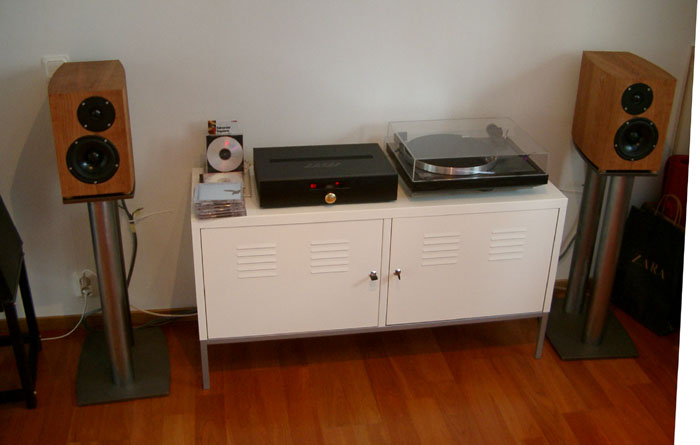
Hej Troels, I
förrgår blev dom klara och lät bra! Fast efter
en stund upptäckte hustrun att det ibland
skrapade lite....jag blev riktigt sur! Efter en
stunds lyssnande och funderande kom jag fram till
att det bara var på vissa frekvenser och bara
på höger diskant. DVS troligen någon lödning
som inte höll måttet, utan vibrerade vid vissa
frekvenser och då slutade leda ström på ett
bra sätt. Fram med sexkantsnyckeln och av med
elementen för att kunna komma åt filtret. Hmm..
ena lödningen på diskanten ser inget vidare
ut....jag börjar med att bara fixa den....OCH
DET LÖSTE SIG SÅ ENKELT! Nu har jag
lyssnat lite mer och de låter helt enkelt
kanonbra! De gamla HF 90 får stryk vad det
gäller bas, transparens, ljudbild, taktkänsla
(The LINN faktor!) för att inte tala om
utseende! Igår bjöd jag in min granne som har
ett förflutet som musiker och studioägare. Han
undrade direkt om jag hade kopplat fel polaritet
på vinylspelaren eftersom "high
hat:en" på Suzanne Vega´s "Luka"
låg på vänster sida. De brukar alltid ligga
till höger....Vi körde några plattor till och
kom fram till att Suzannes trummis var
vänsterhänt! Det känns som om man har
fått en massa nya bra skivor - allt (nästan, en
del blir tydligt avklädda också) man slänger
på låter bra. Sänder några fler
bilder, nu i full upplösning. De är inte
riktigt bra, men visar i alla fall den färdiga
set-uppen. MVH Max
|
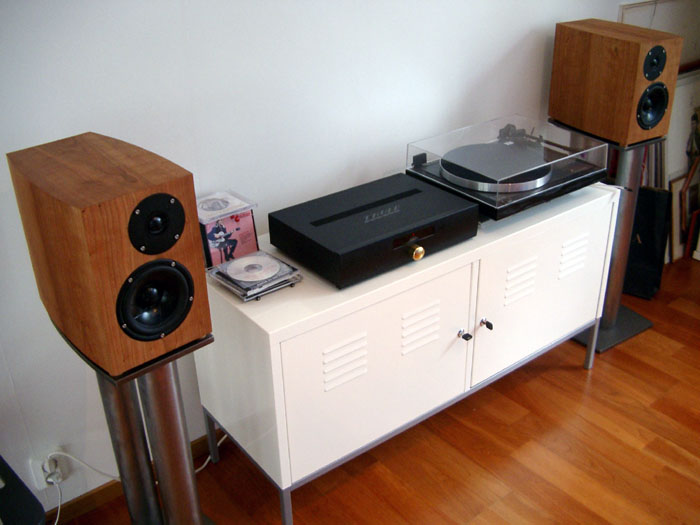
Ellam, built by Emil, Macedonia
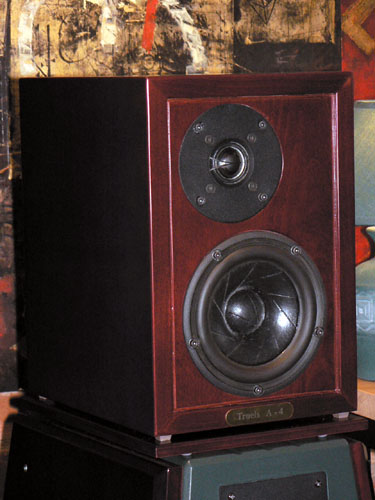 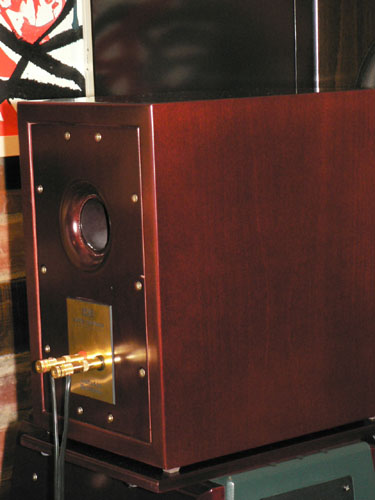
Hi Troels
Enclosed some pics of the A4's I just finished.
These are my third version with these drivers!
Originally I used the Dutch A4 x-over. Frankly, I
was a little disappointed,
the sound was somehow flat and of a separate bass
and treble - as opposed to a coherent one ...
Later I tried a three-element (no cap) series
x/over . The sound was different, albeit not
necessarily better - more bass (a lot more - I
guess the L2 inductor was not the happiest
choice) and the whole thing sounded too mellow,
syrupy. Anyway, after Papa and Mama Bear,
now came the Baby Bear ! The Ellam is just right
!
Having listened to it a couple of days (still
breaking in, the units were not used for a
several months), and confirming the impressions
with my audio friend and a cousin (himself a
Lowther and tube type), I can say that the system
- the crossover first and foremost - is very
accurate , coherent and balanced at both ends.
The bass is superb (but we all know already about
the bass capabilities of the small 15W) , the
mids are very smooth ( although not as detailed
and of studio-monitor-type class as in 18SP38 )
and the highs are perfect! The metal dome D2800
is really a top driver but it
takes a proper x/over to exploit it.
In short - an excellent small-box system, of a
highest caliber . Reminded me very much of an
original ProAc Tablette - similar easy
presentation , but with a lot more bass.
Regards,
Emil Andreevski
|
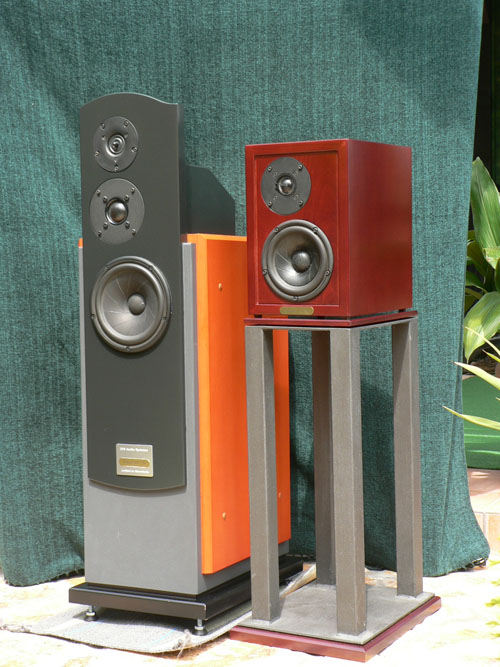
The Ellam aside the SP38.
|